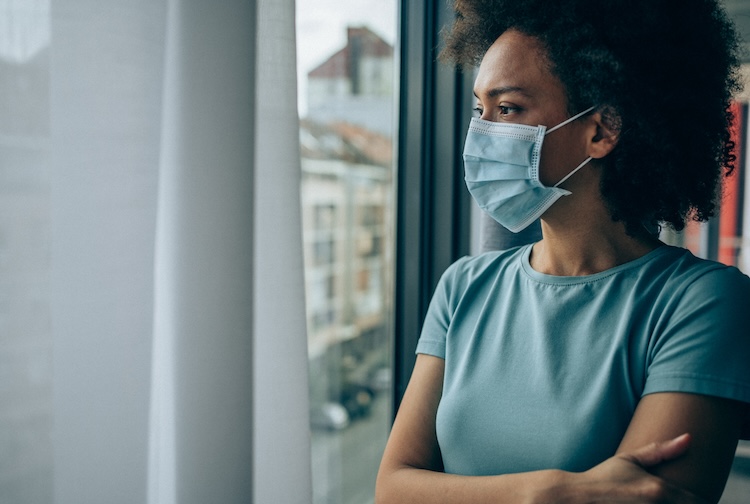
What we know about the uptick in COVID-19 cases
VCU Health expert points to waning immunity and new COVID-19 strain as factors to the increase of cases in Virginia.
August 24, 2023 As of mid-August, the most prominent strain of COVID-19 being found in communities is called EG.5 or Eris. (Getty Images)
As of mid-August, the most prominent strain of COVID-19 being found in communities is called EG.5 or Eris. (Getty Images)
By Sara McCloskey
COVID-19 might not be top of mind for most people nowadays. But every week since late June, patients diagnosed with the illness have steadily increased across the commonwealth.
Virginia Department of Health (VDH) data on these cases is collected from emergency rooms, where patients are tested and treated for their symptoms. While these hospitalization rates are generally low, accounting for less than 2% of emergency visits in Virginia, the increase in cases has drawn the attention of infectious disease experts and medical professionals.
“COVID-19 is never going away and new variants, much like the flu, will be around every year,” said Gonzalo Bearman, M.D., VCU Health’s infectious disease expert.
The most prominent strain being tracked is called EG.5 or Eris. Bearman says health experts suspect this strain is highly transmissible, but they don’t know yet if it causes the general public to become severely ill.
“Disease risk is not the same for everyone. There will also be a higher risk for people with chronic conditions, those who are pregnant and older adults,” Bearman said. “These vulnerable populations need to be on guard regardless of the strain of COVID-19 and stay up to date with the latest vaccinations with their care teams.”
How do we know COVID-19 cases are going up? What’s causing the increase?
Since people who take tests at home are not required to report that they’ve contracted COVID-19 to health departments, Bearman says cases are under reported. So, health departments tracking COVID-19 cases use hospitalization rates, emergency room visits and the number of deaths to estimate the prevalence of the virus in communities. These figures are often released 2 to 3 weeks after someone is diagnosed or dies from the virus.
If you're interested in looking at this data yourself, it’s available on the VDH and Centers for Disease Control and Prevention’s (CDC) websites.
There are a few factors that may be causing the increase in cases. Our immunity — built up from COVID-19 boosters — is waning as we wait for the latest vaccine to be released. The consistent high temperatures caused many to spend more time indoors, which always makes it easier for respiratory viruses to spread. New strains of COVID-19 also contribute to more cases, Bearman says.
When will the new booster be available? Will it be effective against this COVID-19 strain?
The vaccine rollout is changing slightly this year because the federal Public Health Emergency for COVID-19 ended in May. Instead of the federal government to purchasing vaccines and overseeing distribution, it will be transitioned to the commercial market.
The newest COVID-19 vaccine is not commercially available yet, but state and local health experts expect it to be in pharmacies, doctors’ offices and other locations sometime in late-September or early October. As of mid-August, providers are still waiting on information from the CDC about this year’s vaccine and recommendations for who should get it.
“While the current bivalent vaccine is not up to date with the latest COVID-19 strains, it will offer some benefit when it comes to preventing severe illness,” Bearman said. “It’s always better to get vaccinated to protect yourself from the virus than to not get the shot at all.”
The CDC still recommends all people stay up to date on their COVID-19 vaccinations. For most people 5 years and older, that means they should have one dose of the current bivalent COVID-19 vaccine. People who are immunocompromised or over the age of 65 years may consider receiving a second dose of the bivalent booster.
As of August 23, VDH estimates 74% of Virginia’s population has received the first series of COVID-19 vaccines, but only 18% are up to date with their boosters.
Will there be another “tridemic” situation this fall and winter?
You may remember that there were three different respiratory illnesses circulating in communities last fall and winter, commonly referred to as the “tridemic” or “triple epidemic.” All of these illnesses — flu, respiratory syncytial virus (RSV) and COVID-19 — are highly transmissible, especially indoors.
While some people may be worried about kids returning to school during this uptick in COVID-19 cases, Bearman says he’s more worried about repeated risk for a tridemic during the winter respiratory illness season.
“There is an increasing risk of contracting a respiratory virus when the weather gets colder,” Bearman said. “Physicians should be encouraging voluntary vaccinations to the fullest extent possible, especially for medically vulnerable populations.”
How can we stay safe amid this current rise in numbers?
As we have experienced, there is much uncertainty when it comes to this illness and changes can happen quickly. The best way to protect from COVID-19, Bearman says, is to stay up to date on vaccinations and boosters. If you have any questions or concerns, do not hesitate to reach out to your primary care provider.
Many of the lessons we learned about health and safety during the pandemic can also apply when there are upticks in cases of COVID-19, flu or other illnesses. These tips include:
- Wash your hands often with soap and water for at least 20 to 30 seconds. Avoid touching your eyes and mouth as much as possible.
- Close contact with others can spread viruses. This includes shaking hands, sharing drinks or utensils, or kissing.
- If you are sick: stay home. Try to avoid contact with others as much as possible.
- Use tissue paper or your upper sleeve to cover your cough and sneeze.
- Consider wearing masks, particularly if you are in a crowded public place (like a public bus or train) or if you’re around others who may be sick or at high risk of getting severely ill.



